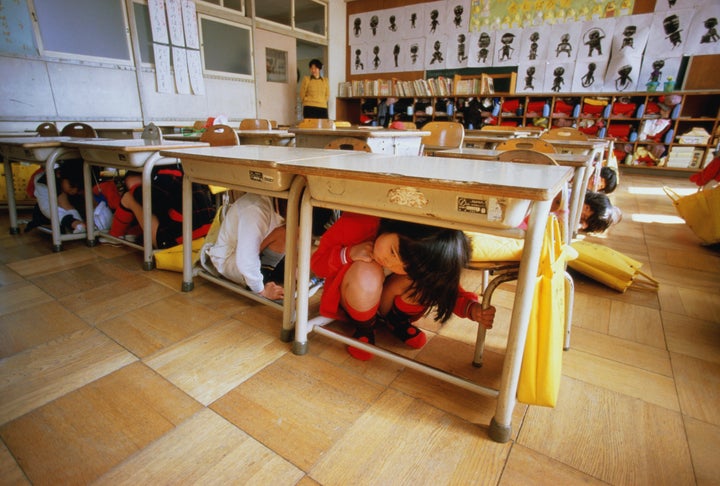
My son is more sensitive than many of his peers. When he was a toddler, he hated fireworks, feared action movies, and was wary of swimming, large crowds and loud noises. His heightened sensitivity is one small, lovely part of who he is, and we do our best to guide him through troublesome events with dialogue and love. As a parent, I empathize with his worries, but try not to highlight them. He is a happy kid who loves school and play equally — most of the time.
What I didn’t plan for were the sleepless nights he would endure because of decisions other adults make: the decisions by schools to immerse small children into a world full of grown-up fears.
The first set of nightmares happened within the first month of kindergarten. My son tossed and turned, slept fitfully and cried out for me on more than one occasion. Since he wasn’t prone to confessing his anxieties without a lot of digging, it took the help of his Care Bear and a stuffed cat named Bella sharing tales of their own tough days at stuffed animal school to get the story.
“At school,” my child told his fluffy confidants, “we all had to practice what we would do if a bad man came in to hurt us. It was scary.”
My son was barely 5. His worries should have consisted of how to Velcro his own shoes, zip his own jacket and not fall off his chair while eating dinner. He should not, under any circumstances, have been losing sleep over fear that “bad men” would show up at school the next day. Gender stereotypes aside, this is a fear that we do not need to project onto our already overloaded 21st-century progeny.
Yes, teach our tiny ones to be prepared. Tell them they’re doing a drill to keep them safe, and that the most important thing they can do in any emergency is listen to their teacher. In kindergarten, that’s enough. It should not be incumbent on our children to protect themselves and others from “bad men.”
These fear-inducing incidents continued, here and there, and seldom included a note home. There were more active shooter drills and loud hallway alarms without warning, exacerbated by a teacher who lacked barriers, including once reading to the children a book complete with a picture of a shiny handgun pointed at the back of Abraham Lincoln’s head.
“[My son] should not, under any circumstances, have been losing sleep over fear that 'bad men' would show up at school the next day ... this is a fear that we do not need to project onto our already overloaded 21st-century progeny.”
My son is at a new school now, and much less anxious. Or so I believed, until second grade.
He awoke, crying out, in the middle of the night. One wake up. And then another. And another. Out of bed seven times. I soothed him, then placed a trash can next to his bed (at 2 a.m., isn’t it usually about vomit?). Finally, he slept — yet never got sick. What had kept him awake?
We discovered the answer early the next morning. In an email from the school sent after-hours that both my husband and I had somehow missed, we learned the school had participated in a fire safety drill.
Yes! Bring it on, I thought. My son was also terrified of fire, so a practical lesson on staying safe was important.
However, instead of a simple school evacuation drill, activity sheets or a lecture on not playing with matches (circa 1978) from the fire chief, the message said this:
Students [will] participate in a smoke-filled room simulation. For the simulation, students will go into a trailer that is filled with [fake] smoke. Students will learn how to crawl out of smoke. Please be sure to talk to your child tonight or tomorrow morning about this so they are not scared tomorrow!
A smoke-filled room simulation in elementary school.
Emergency simulations are for EMTs, SWAT teams and teachers — not for 6- and 7-year-olds who should focus on being kind, standing up to bullies and playing four square at recess. Instead, my child now had nightmares.
Some schools are taking it even further. In Florida, an entire high school was sent into a panic after intentionally not telling students in advance that they were conducting an active shooter drill. And recently, a Colorado school made the decision that not only should schools prepare students to run from a shooter, but also prepare them to fight back ― as if our children, not adults, should be responsible for acting the hero instead of protecting themselves.
Our schools are serving up a heaping platter of anxiety to our children. When do we allow them to be children? Between too much homework, too much technology and not enough recess, our kids are already overwhelmed. Do we need to add bad men, fake smoke and combat tactics?
Emergency preparedness in school is nothing new. Hordes of baby boomers came out of the ’50s emotionally scarred from Bert the Turtle bomb safety videos and “duck and cover” drills (as if ducking under a 2-foot-tall desk would have protected one from an atomic bomb). My mother remembers the drills — and the fear — to this day.
“Tell me, Mom, did you ever need to actually duck and cover, due to real atomic bombs, in your childhood?” I asked her, shortly after my little guy’s frightful incident.
“Um, no,” she replied.
“Did you find these drills useful at any point in your entire life?”
“Um, no.”
Luckily, by the time I was a kid, grown-ups had more common sense. In the golden 1970s, safety drills were not on the list of things that kept us up at night. Don’t get me wrong ― I had plenty of tornado drills as a kid in the Midwest. These consisted of squatting and giggling in the hallway, away from windows, until we heard the all-clear bell. Easy peasy — and not particularly scary.
I agree with the need to teach our kids how to stay as safe as possible in dangerous situations — particularly in light of the very real tragedies we’ve seen in recent years, and in light of ongoing and serious threats toward certain communities. But there are many ways to keep it kid-friendly, just as we do when we are teaching them other basic life skills.
When I teach my toddler to not walk into the street, I don’t show him graphic visuals of mangled limbs, or drive a pretend car at him so he can leap out of the way. I simply say, “Cars are dangerous, and if you cross the street without a grown-up, you might get hurt.” We practice crossing while holding hands and looking both ways. There is no need to warn our smallest children about crushed body parts — or about bad men coming into schools.
“Let’s save the realistic simulations — and the fear — for grown-ups. ... There is a fine line between teaching children to make good decisions and forcing them to think — and worry — like tiny grown-ups.”
Other parents I’ve spoken with, particularly those who have children with anxiety or sensory issues, share this concern about safety drills. As one colleague expressed, “My first grader was so afraid the monthly fire drill would occur while she was going to the bathroom that she was holding it all day and eventually had an accident in class.”
Most parents agreed that the drills are, unfortunately, necessary — but they don’t need to be extreme or terrifying. For children with anxiety, a history of trauma, or other needs, paying extra care to how these drills are done can make a huge difference. The National Association of School Psychologists offers useful tips here.
Please, give my young children emergency safety drills. Have them crawl across the floor of their classrooms and giggle with their friends while they talk about fire safety. Sit them in the back corner of the room — with no actual threats — and have them practice listening to the teacher and keeping quiet. And, as they get older, talk to them in age-appropriate ways about the important systemic issues that underlie some of these dangers — from gun policies to privilege to power.
Let’s save the realistic simulations — and the fear — for grown-ups, however. There is a fine line between teaching children to make good decisions and forcing them to think — and worry — like tiny grown-ups.
Imagine, for a moment, that my childhood school from the ’70s had decided on a realistic tornado simulation instead of squatting and giggling in the hallways. I can almost picture the letter home:
Dear parent: Tomorrow we will have a school-wide tornado simulation. We will turn off all the lights, rattle the windows, blow industrial-strength fans through the hallways and play a loud roaring noise over the loudspeakers … Please be sure to talk to your child about this so they are not scared!
Rebecca Swanson lives in Colorado with her husband and two sons. Her essays have appeared in The New York Times, The Washington Post and elsewhere. She is currently working on middle grade and young adult novels that center neurodiversity. Follow her on Twitter at @RebeccaLSwanson.
Do you have a personal story you’d like to see published on HuffPost? Find out what we’re looking for here and send us a pitch!
